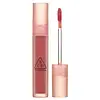3CE Blur Water Tint Versus Romand Blur Fudge Tint
What's inside
What's inside
 Key Ingredients
Key Ingredients

No key ingredients
 Benefits
Benefits

 Concerns
Concerns

 Ingredients Side-by-side
Ingredients Side-by-side

Water
Skin ConditioningDimethicone
EmollientDimethicone/Vinyl Dimethicone Crosspolymer
Skin ConditioningGlycerin
HumectantAlcohol Denat.
AntimicrobialPentylene Glycol
Skin ConditioningPolyglyceryl-10 Myristate
Skin ConditioningPolyacrylate Crosspolymer-6
Emulsion StabilisingDimethicone Crosspolymer
Emulsion StabilisingButylene Glycol
HumectantCeteareth-20
CleansingEthylhexylglycerin
Skin ConditioningTrisodium Ethylenediamine Disuccinate
Aluminum Hydroxide
EmollientAmmonium Polyacrylate
StabilisingArginine
MaskingT-Butyl Alcohol
PerfumingCarbomer
Emulsion StabilisingPhenoxyethanol
PreservativeParfum
MaskingCI 77891
Cosmetic ColorantCI 15985
Cosmetic ColorantCI 17200
Cosmetic ColorantCI 19140
Cosmetic ColorantCI 42090
Cosmetic ColorantWater, Dimethicone, Dimethicone/Vinyl Dimethicone Crosspolymer, Glycerin, Alcohol Denat., Pentylene Glycol, Polyglyceryl-10 Myristate, Polyacrylate Crosspolymer-6, Dimethicone Crosspolymer, Butylene Glycol, Ceteareth-20, Ethylhexylglycerin, Trisodium Ethylenediamine Disuccinate, Aluminum Hydroxide, Ammonium Polyacrylate, Arginine, T-Butyl Alcohol, Carbomer, Phenoxyethanol, Parfum, CI 77891, CI 15985, CI 17200, CI 19140, CI 42090
Dimethicone
EmollientDimethicone Crosspolymer
Emulsion StabilisingTribehenin
EmollientDiisostearyl Malate
EmollientCI 77891
Cosmetic ColorantPolyglyceryl-2 Triisostearate
EmulsifyingVinyl Dimethicone/Methicone Silsesquioxane Crosspolymer
Sorbitan Isostearate
EmulsifyingVp/Hexadecene Copolymer
Cetyl PEG/PPG-10/1 Dimethicone
EmulsifyingParaffin
PerfumingCI 77492
Cosmetic ColorantCI 77491
Cosmetic ColorantMica
Cosmetic ColorantCI 19140
Cosmetic ColorantCI 15850
Cosmetic ColorantMicrocrystalline Wax
Emulsion StabilisingBenzyl Benzoate
AntimicrobialPolyglyceryl-2 Diisostearate
EmulsifyingDehydroacetic Acid
PreservativeCI 77499
Cosmetic ColorantCI 45410
Cosmetic ColorantCI 42090
Cosmetic ColorantParfum
MaskingTriethoxycaprylylsilane
Anise Alcohol
PerfumingMacadamia Integrifolia Seed Oil
Skin ConditioningPentaerythrityl Tetra-Di-T-Butyl Hydroxyhydrocinnamate
AntioxidantTocopherol
AntioxidantDimethicone, Dimethicone Crosspolymer, Tribehenin, Diisostearyl Malate, CI 77891, Polyglyceryl-2 Triisostearate, Vinyl Dimethicone/Methicone Silsesquioxane Crosspolymer, Sorbitan Isostearate, Vp/Hexadecene Copolymer, Cetyl PEG/PPG-10/1 Dimethicone, Paraffin, CI 77492, CI 77491, Mica, CI 19140, CI 15850, Microcrystalline Wax, Benzyl Benzoate, Polyglyceryl-2 Diisostearate, Dehydroacetic Acid, CI 77499, CI 45410, CI 42090, Parfum, Triethoxycaprylylsilane, Anise Alcohol, Macadamia Integrifolia Seed Oil, Pentaerythrityl Tetra-Di-T-Butyl Hydroxyhydrocinnamate, Tocopherol
Ingredients Explained
These ingredients are found in both products.
Ingredients higher up in an ingredient list are typically present in a larger amount.
CI 19140 is also known as Tartrazine. Tartrazine is a synthetic dye used in cosmetics, foods, and medicine to add a yellow color.
Tartrazine is created from petroleum and is water-soluble.
Some people may experience allergies from this dye, especially asthmatics and those with an aspirin intolerance.
Learn more about CI 19140Ci 42090 is a synthetic dye created from petroleum. It is used to give a bright blue color to cosmetics, medicine, and food.
Ci 77891 is a white pigment from Titanium dioxide. It is naturally found in minerals such as rutile and ilmenite.
It's main function is to add a white color to cosmetics. It can also be mixed with other colors to create different shades.
Ci 77891 is commonly found in sunscreens due to its ability to block UV rays.
Learn more about CI 77891Dimethicone is a type of synthetic silicone created from natural materials such as quartz.
What it does:
Dimethicone comes in different viscosities:
Depending on the viscosity, dimethicone has different properties.
Ingredients lists don't always show which type is used, so we recommend reaching out to the brand if you have questions about the viscosity.
This ingredient is unlikely to cause irritation because it does not get absorbed into skin. However, people with silicone allergies should be careful about using this ingredient.
Note: Dimethicone may contribute to pilling. This is because it is not oil or water soluble, so pilling may occur when layered with products. When mixed with heavy oils in a formula, the outcome is also quite greasy.
Learn more about DimethiconeDimethicone Crosspolymer is a silicone created by modifying dimethicone with hydrocarbon side chains. Due to its large size, it does not penetrate skin. It is considered non-occlusive.
Dimethicone Crosspolymer is used to stabilize and thicken products. It also helps give products a silky feel.
Parfum is a catch-all term for an ingredient or more that is used to give a scent to products.
Also called "fragrance", this ingredient can be a blend of hundreds of chemicals or plant oils. This means every product with "fragrance" or "parfum" in the ingredients list is a different mixture.
For instance, Habanolide is a proprietary trade name for a specific aroma chemical. When used as a fragrance ingredient in cosmetics, most aroma chemicals fall under the broad labeling category of “FRAGRANCE” or “PARFUM” according to EU and US regulations.
The term 'parfum' or 'fragrance' is not regulated in many countries. In many cases, it is up to the brand to define this term.
For instance, many brands choose to label themselves as "fragrance-free" because they are not using synthetic fragrances. However, their products may still contain ingredients such as essential oils that are considered a fragrance by INCI standards.
One example is Calendula flower extract. Calendula is an essential oil that still imparts a scent or 'fragrance'.
Depending on the blend, the ingredients in the mixture can cause allergies and sensitivities on the skin. Some ingredients that are known EU allergens include linalool and citronellol.
Parfum can also be used to mask or cover an unpleasant scent.
The bottom line is: not all fragrances/parfum/ingredients are created equally. If you are worried about fragrances, we recommend taking a closer look at an ingredient. And of course, we always recommend speaking with a professional.
Learn more about Parfum